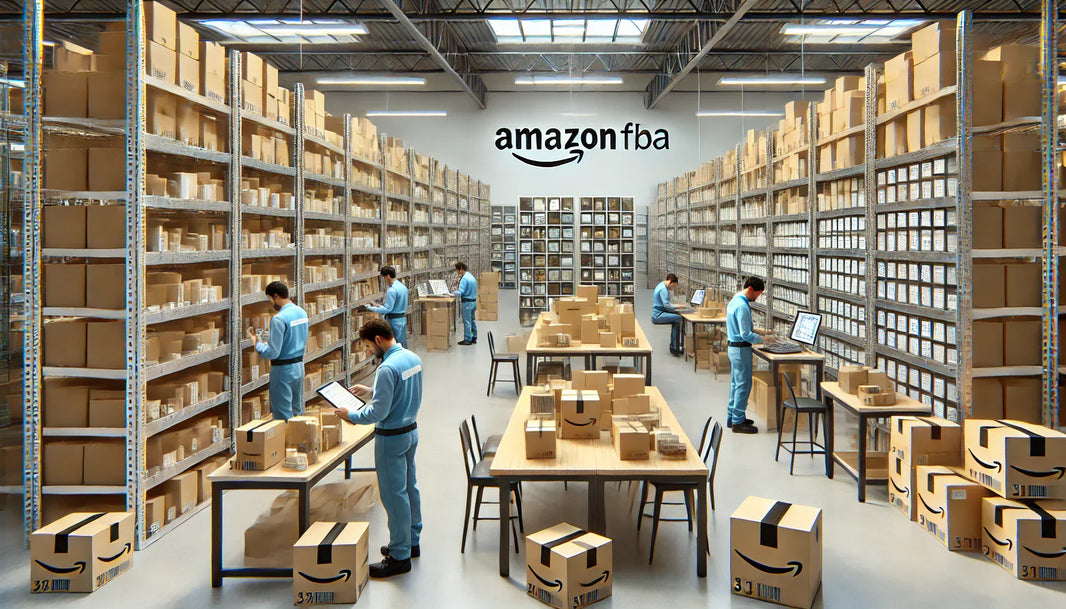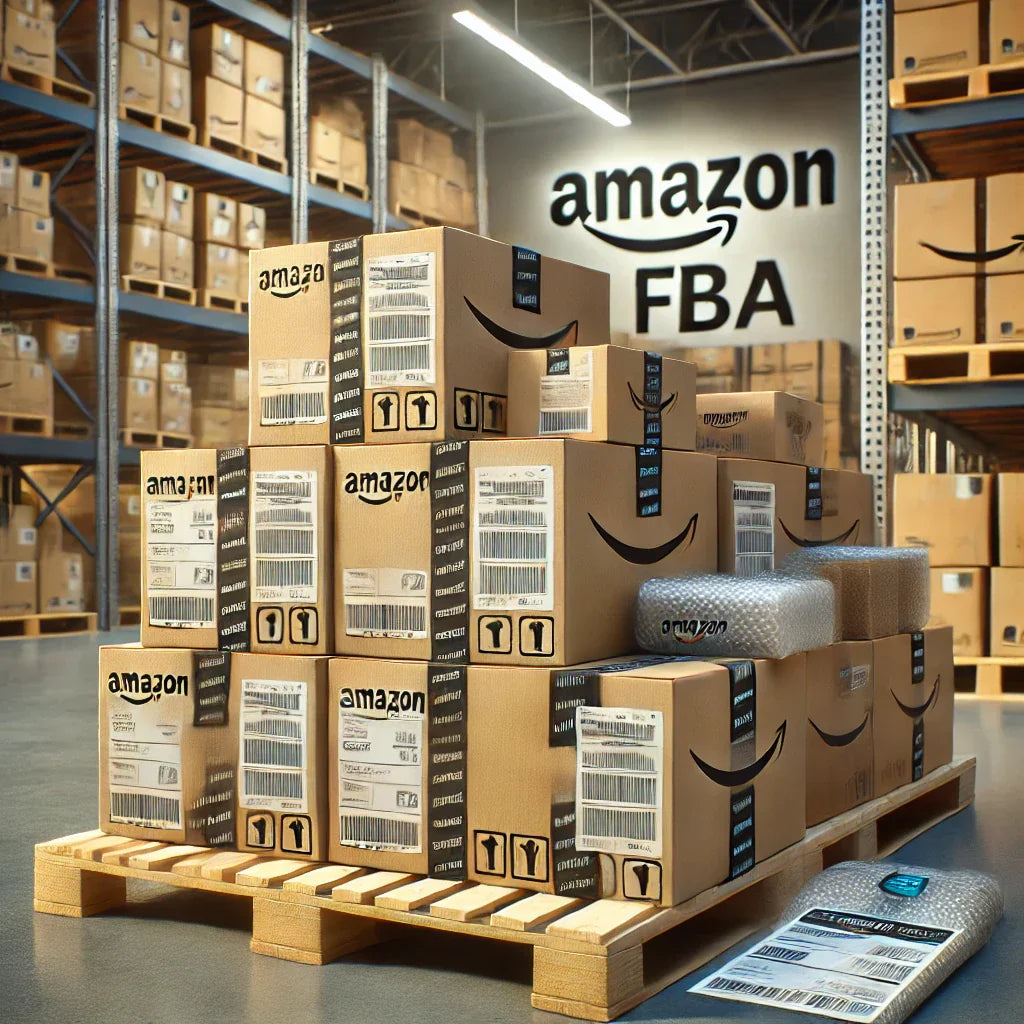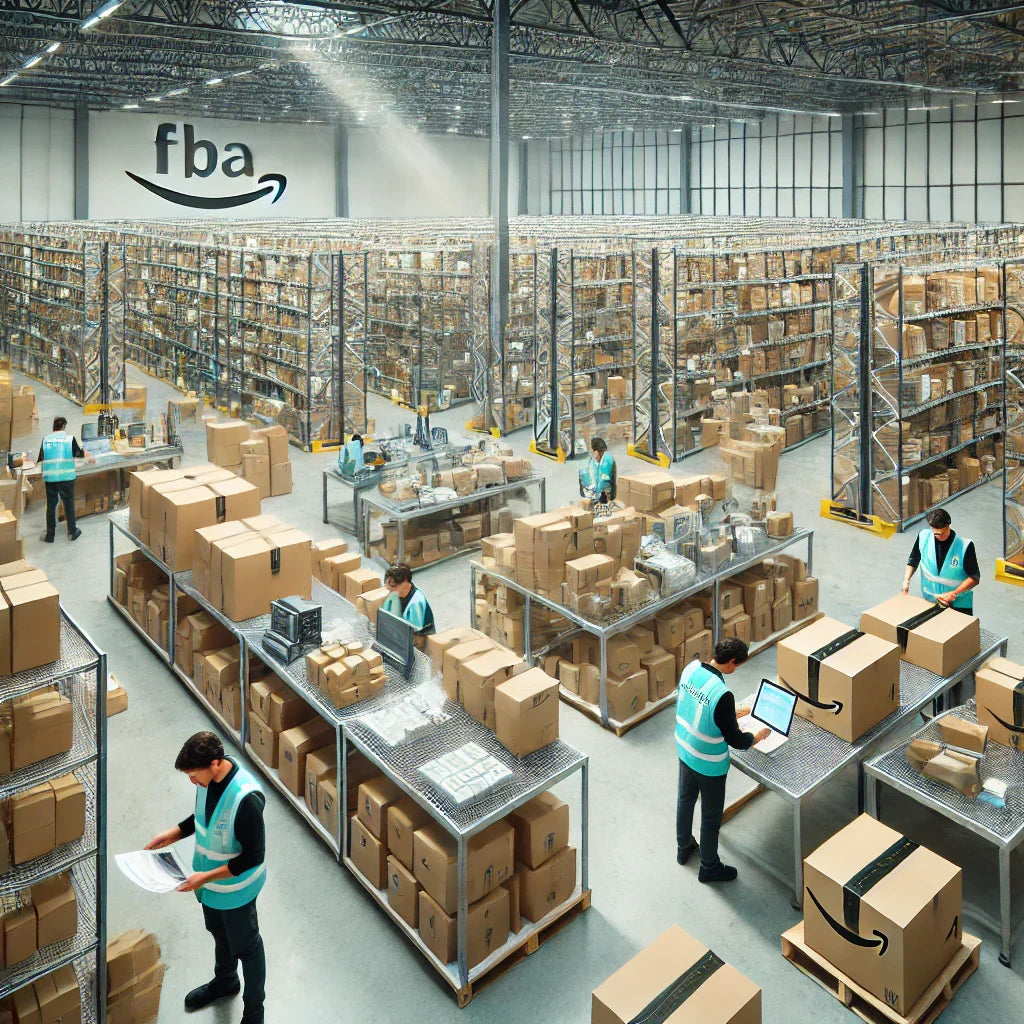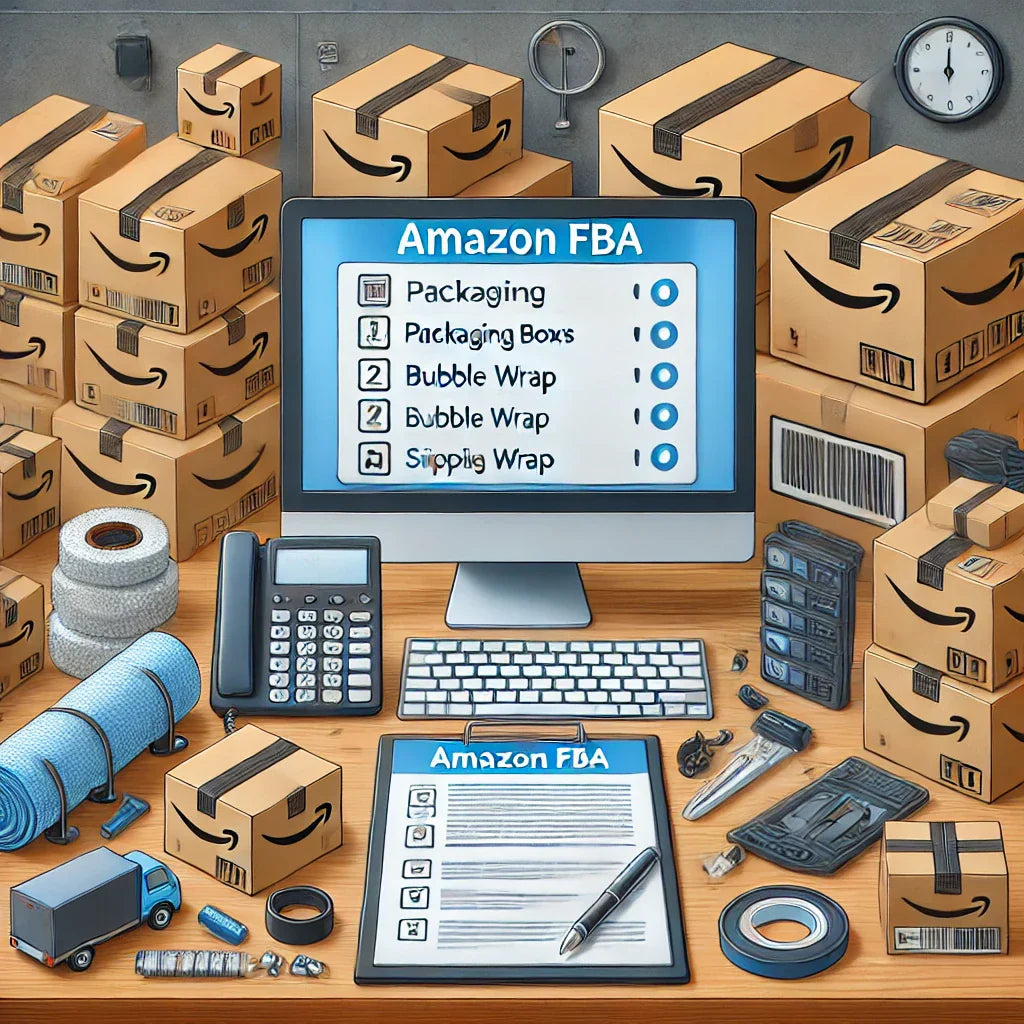Navigating the logistics of Amazon's Fulfillment by Amazon (FBA) program can be challenging, especially for sellers aiming to meet Amazon's strict inbound requirements. Inbound prep services are crucial for ensuring that products meet Amazon's standards before reaching the fulfillment centers, avoiding potential delays and costly errors. From labeling to packaging and quality checks, a well-chosen prep center can streamline the FBA inbound process, helping sellers focus on scaling their business. This guide will outline what Amazon sellers need to know about choosing and leveraging inbound prep services to optimize their FBA operations effectively.

The Role of Inbound Prep Services in Amazon FBA
For Amazon FBA sellers, managing the intricate logistics of preparing items for fulfillment centers is often one of the most challenging aspects of running a successful business. Inbound prep services exist to bridge this gap, offering comprehensive services that ensure your inventory meets Amazon's requirements for storage, handling, and shipping. These services can include everything from product inspection and labeling to packaging and bundling.
Inbound prep services, provided by dedicated FBA prep centers or Amazon prep centers, specialize in supporting sellers by adhering to Amazon’s FBA guidelines. These centers are well-versed in Amazon’s standards and know how to avoid common issues that could lead to rejections, delays, or additional costs.
Why Sellers Should Consider Inbound Prep Services
There are several compelling reasons why inbound prep services are essential for Amazon sellers, especially those scaling their operations:
- Efficiency and Time Management: Managing FBA inventory is time-intensive. Inbound prep services streamline the preparation process, freeing up time to focus on other aspects of the business.
- Reduced Errors: Amazon has strict requirements for FBA inventory. Missteps in packaging, labeling, or documentation can lead to penalties. Prep centers have systems to avoid these costly mistakes.
- Improved Inventory Turnaround: With quicker, more efficient prep, inventory can be shipped to FBA centers faster, ensuring product availability and reducing stockouts.
What to Expect from an FBA Prep Center
The services offered by an FBA prep center may vary, but they generally provide a suite of solutions tailored to Amazon’s strict FBA guidelines. Sellers can expect the following services from a reputable prep center:
1. Labeling and Barcoding
One of the essential services FBA prep centers offer is correct labeling and barcoding. Each item sent to Amazon's fulfillment centers must have scannable barcodes to track inventory accurately. Whether the products have manufacturer barcodes or require additional labels, FBA prep centers ensure compliance with Amazon’s labeling rules.
2. Inspection and Quality Control
Inbound prep services often include inspection to verify that products are in the correct condition, free of defects, and meet quality standards. By conducting thorough checks, FBA prep centers minimize the chances of damaged or defective items reaching customers, which could lead to poor reviews and returns.
3. Bundling and Kitting
FBA prep centers provide kitting and bundling services for sellers offering products in sets or groups. This process ensures that multi-pack items, bundles, or specially packaged products are correctly assembled, labeled, and packaged per Amazon’s FBA guidelines.
4. Poly Bagging and Shrink Wrapping
Products that require additional protection often need poly bagging or shrink wrapping. Many prep centers offer this service, ensuring that items are securely packaged and meet Amazon’s packaging requirements, including suffocation warning labels for poly bags.
5. Packaging and Re-Packaging
If your products arrive at a prep center with inadequate or damaged packaging, they can be repackaged according to Amazon’s standards. This service is invaluable for items purchased from suppliers that may not be familiar with FBA guidelines, ensuring all packaging requirements are met.
Choosing the Right Amazon Prep Center for Your Business
Selecting the right Amazon prep center can be pivotal to maintaining efficient and error-free logistics. Here are some considerations to guide you in choosing a reliable prep service provider:
1. Location
Choosing an Amazon prep center located close to your suppliers or to Amazon’s fulfillment centers can reduce shipping time and costs. Centers situated in logistics hubs can expedite the inbound process and enable quicker restocking.
2. Service Range and Customization
Each seller’s needs are unique, so it’s essential to select a prep center that offers a comprehensive range of services and allows for some degree of customization. For instance, if you sell fragile products that require extra care in packaging, ensure that the prep center can handle those requirements.
3. Compliance with Amazon FBA Standards
Amazon’s FBA guidelines are strict, and any lapses can lead to penalties or delays. A trustworthy FBA prep center will be well-versed in these regulations, adhering to Amazon’s standards to ensure all prepared products meet the necessary requirements.
4. Pricing Structure
Cost is a key consideration. Evaluate the prep center’s pricing structure and ensure transparency in charges for different services. Some centers charge a flat fee, while others have tiered pricing based on volume or services rendered. Compare multiple providers to find a balance between cost and quality.
5. Reputation and Experience
Assess the experience and reputation of the prep center. Experienced prep centers understand Amazon’s requirements well and have a track record of effectively handling high volumes. Check online reviews and ask for references to gauge the center's reliability.
Key Benefits of Using Amazon Prep Centers for FBA
Amazon prep centers are vital in streamlining the entire FBA process for sellers. Here are some benefits that can make a significant impact on your business operations:
1. Error Reduction and Compliance Assurance
By using a specialized prep center, sellers minimize errors related to labeling, packaging, and other FBA requirements. This prevents issues that could otherwise result in inventory rejection or costly delays.
2. Enhanced Inventory Management
Many Amazon prep centers offer inventory tracking and management services, ensuring that sellers maintain optimal stock levels at Amazon fulfillment centers. This feature can be particularly beneficial for larger inventories, reducing stockouts and optimizing turnaround times.
3. Cost Savings in the Long Run
While there’s a fee for using an inbound prep service, the cost savings can add up. By ensuring compliance, reducing rejections, and preventing shipping issues, these services help avoid costly errors that impact profitability.
How Inbound Prep Services Support Scaling on Amazon
Scaling an Amazon FBA business involves expanding inventory, increasing sales volume, and managing complex logistics. Inbound prep services support scaling by alleviating the burden of inventory preparation, a crucial element of Amazon FBA success.
Automation and Efficiency
Prep centers automate processes like labeling and packaging, enabling higher efficiency for sellers scaling up. This automation can be especially advantageous as order volumes grow, ensuring that the prep service can handle increased demand.
Streamlined Logistics for Higher Volume
When order volumes rise, the logistical complexity of preparing items for Amazon FBA can become overwhelming. An experienced Amazon prep center can manage large volumes effectively, ensuring quick turnaround times and allowing sellers to focus on growth initiatives.
Inventory Flexibility
With inbound prep services, sellers can store excess inventory at the prep center if needed, which is especially useful during peak sales seasons. This flexibility helps avoid Amazon’s storage fees, as sellers only ship inventory when necessary.

Risks and Considerations of Using Inbound Prep Services
While inbound prep services offer numerous advantages, it’s essential to weigh potential drawbacks. Understanding these risks allows sellers to make an informed choice about outsourcing preparation tasks.
1. Additional Costs
Inbound prep services come with associated fees, which can increase operational costs. Sellers should carefully assess whether these costs are offset by the efficiency and error reduction offered by a prep center.
2. Potential for Miscommunication
Outsourcing to a prep center requires clear communication, as misunderstandings about product specifications or preparation requirements could lead to costly mistakes. Establish clear guidelines with your prep center to minimize the risk of miscommunication.
3. Reliance on Third-Party Providers
Using a third-party prep center means relinquishing some control over the preparation process. It’s crucial to choose a reliable provider to minimize issues that could arise from outsourcing.
Best Practices for Working with an FBA Prep Center
To maximize the benefits of an Amazon prep center, consider the following best practices to streamline communication and improve efficiency.
1. Establish Clear Product Requirements
Before sending inventory to the prep center, provide detailed instructions for each product’s requirements. This includes labeling details, packaging preferences, and any other specifications unique to your product line.
2. Maintain Regular Communication
Communication is essential in ensuring smooth operations. Regularly check in with your prep center, especially if there are any changes to your products or preparation requirements.
3. Monitor Performance
Periodically review the performance of your inbound prep service. Ensure they are meeting Amazon’s standards consistently, and track key metrics like turnaround time and error rates.
4. Have a Contingency Plan
Sometimes, issues may arise that delay preparation and shipping. Having a backup plan or an alternative prep center can provide reassurance and keep your business running smoothly during peak sales seasons.
How to Transition to Using Inbound Prep Services for Your Amazon FBA Business
Transitioning to an inbound prep service can optimize your operations but requires careful planning to integrate effectively into your business model. Here’s how to make the transition smooth, cost-effective, and aligned with your business goals:
1. Research and Select the Right Prep Center
Selecting the right prep center is foundational. Research providers that offer the services you need, whether it’s bundling, kitting, labeling, or handling specialized packaging requirements. Compare their locations, costs, and reputations. Additionally, consider any unique needs your product may have, such as fragile item handling or temperature-controlled environments, and confirm the prep center can accommodate them.
- Request Trial Services: If possible, opt for a trial period or a small test batch to evaluate the provider’s quality and efficiency.
- Seek Reviews and Recommendations: Connect with other Amazon sellers in forums or social media groups to learn about their experiences with various prep centers.
2. Test with a Small Batch of Inventory
Testing with a small inventory batch allows you to evaluate the prep center’s processes, quality control, and turnaround time. Choose a selection of products that represents a range of your inventory to assess how well the center handles different items. During this test phase, monitor closely for any discrepancies in labeling, packaging quality, or shipment timing.
- Track Performance Metrics: Key metrics like preparation time, error rates, and customer feedback (if items are sent directly to FBA) provide insight into the prep center’s reliability.
- Evaluate Communication: Note the responsiveness of the prep center during this phase. Clear and consistent communication is vital for handling any potential issues as you scale.
3. Establish Clear SOPs (Standard Operating Procedures)
Developing detailed Standard Operating Procedures (SOPs) for your product preparation ensures that all parties involved understand your expectations. SOPs should outline packaging, labeling, bundling, inspection standards, and any specific requirements for fragile or perishable items. Clear SOPs reduce errors, as the prep center staff has a reference for your standards, particularly as you increase your shipment volumes.
- Include Visuals and Examples: Visual aids can enhance the effectiveness of your SOPs. Photos of correctly prepared items, examples of labeled packages, and descriptions of acceptable packaging help clarify your expectations.
- Regularly Update SOPs: As your business grows or Amazon updates its requirements, review and revise your SOPs to ensure they reflect current needs and standards.
4. Develop a Consistent Inventory Management Workflow
Efficient inventory management is crucial when transitioning to a prep center. Ensure a streamlined process for sending products to the prep center, scheduling shipments to FBA, and tracking stock levels to prevent stockouts or overstock situations. Many FBA prep centers offer inventory management solutions, helping you keep track of inventory from supplier to customer.
- Integrate Inventory Management Software: Tools like RestockPro, InventoryLab, or SellerCloud can simplify this workflow, allowing you to monitor stock levels, set automatic reorder points, and organize inventory data in real-time.
- Use Demand Forecasting: Incorporate forecasting techniques to anticipate inventory needs during peak seasons or sales events. Coordinating with the prep center on expected volume increases will help them prepare for your needs, preventing delays.
5. Negotiate a Transparent Pricing Agreement
Ensure you understand the pricing structure before committing to a prep center. Some centers may offer flat rates, while others have tiered or per-item fees. Clarify charges for each service—such as labeling, kitting, or poly bagging—and confirm there are no hidden fees. Establishing a transparent pricing agreement upfront will prevent unexpected costs and help you budget more accurately.
- Assess Discounts for High Volume: Many prep centers offer discounts for larger inventory volumes or long-term contracts. Inquire about potential savings if you plan to scale and increase the volume of items prepared.
- Review Billing Statements Regularly: Check invoices periodically to ensure there are no discrepancies. Maintaining clear records of expenses will also be beneficial for analyzing the cost-effectiveness of outsourcing preparation services.
6. Train Your Team on Prep Center Collaboration
If you have a team managing your FBA operations, training them on how to work with an inbound prep center is essential. This includes understanding the SOPs, knowing which products require special handling, and familiarizing themselves with the communication protocol. A team that is well-versed in collaborating with the prep center will enhance workflow efficiency and ensure that all parties stay aligned.
- Assign Key Points of Contact: Designate specific individuals as liaisons between your team and the prep center. This minimizes miscommunication and streamlines information sharing.
- Encourage Proactive Issue Resolution: Training your team to proactively address issues, such as labeling discrepancies or inventory shortages, helps avoid delays in the prep center process.
7. Set Up a Reliable Feedback Loop
After your prep center completes an order, gather feedback on the process, especially if this is an initial order. This can involve evaluating the speed, accuracy, and condition of the items prepared. Additionally, if items are listed on Amazon, customer reviews can provide indirect feedback about packaging quality or product presentation.
- Conduct Periodic Performance Reviews: Monthly or quarterly reviews with the prep center can ensure that quality standards remain consistent. Use these reviews to address any recurring issues or to implement improvements in processes.
- Utilize Customer Feedback: If you notice customer complaints related to packaging or product quality, bring these to the prep center's attention so they can address potential issues in future orders.
8. Implement Continuous Improvement Strategies
Even after the transition is complete, continuously monitor and refine your collaboration with the prep center. A commitment to ongoing improvement ensures that your prep process remains efficient and cost-effective as your business evolves.
- Stay Updated on Amazon’s Requirements: Amazon frequently updates its FBA policies and standards, especially for packaging, labeling, and restricted items. Regularly reviewing these guidelines and communicating any changes with your prep center will help maintain compliance.
- Benchmark Against Competitors: Evaluate how other successful FBA sellers manage their prep processes and incorporate best practices where possible. Observing competitor practices can reveal new strategies for improving your operations.

Leveraging Specialized Inbound Prep Services for Different Product Types
Different products require varying levels of preparation, and choosing a prep center that offers specialized services for diverse product categories can be a competitive advantage. Here are examples of how specialized inbound prep services support a wide range of products:
1. Fragile or Delicate Items
Products like glassware, ceramics, or electronics require extra care in packaging and handling. Specialized prep centers often have experience with these items and provide services such as bubble wrapping, double-boxing, and ensuring protective materials meet Amazon’s standards.
2. Perishable and Temperature-Sensitive Goods
For sellers offering perishable items like food products or temperature-sensitive goods, partnering with a prep center equipped with climate-controlled storage is essential. These prep centers can offer refrigerated or frozen storage, meeting Amazon’s requirements for temperature-sensitive products and preventing spoilage.
3. Oversized or Heavy Items
Oversized or heavy items, such as furniture or equipment, often incur higher handling costs and have stricter FBA requirements. Specialized inbound prep services for large items ensure compliance with Amazon’s packaging and labeling standards, avoiding fees associated with non-compliant shipments.
4. Items with Hazardous Materials
Products with hazardous materials, including certain cleaning supplies, batteries, or aerosols, have specific regulations for FBA storage. A prep center experienced with hazardous items will be knowledgeable about the labeling and packaging required to comply with Amazon’s regulations and reduce safety risks.
5. Seasonal and Promotional Bundles
During peak sales seasons or promotional events, many sellers offer bundled products. Specialized prep services ensure that promotional packaging, bundling, and labeling are accurate, preventing delays during high-demand periods.
Cost Management and Budgeting with Inbound Prep Services
Using inbound prep services incurs additional expenses, so effective cost management is crucial. Here are budgeting strategies to help you manage and minimize costs while benefiting from a prep center’s expertise:
1. Calculate the Cost-Benefit of Outsourcing
To determine if outsourcing to an inbound prep service is worthwhile, calculate the cost-benefit by comparing in-house preparation expenses with the cost of using a prep center. This analysis should include labor costs, packaging materials, and the value of time saved.
2. Negotiate Volume-Based Discounts
Many prep centers offer discounts based on monthly volume commitments. If your business experiences predictable high-volume periods, negotiate a discount for these peak times. Alternatively, if you commit to a consistent inventory volume monthly, long-term discounts may be available.
3. Optimize Inventory Turnover
Inventory turnover rates directly impact costs associated with inbound prep services. By optimizing turnover, you reduce the need for excessive storage and handling fees. Consider adjusting product pricing or promotion strategies to maintain efficient turnover.
4. Utilize Amazon's Inventory Placement Service Strategically
Amazon’s Inventory Placement Service can help consolidate shipping to specific locations, reducing costs. However, it incurs its own fees. Consider combining this with prep services strategically to optimize both prep and shipping costs based on demand patterns.
Integrating Automation with Inbound Prep Services
As your Amazon FBA business grows, automation becomes a powerful tool in streamlining processes and reducing manual effort. While many inbound prep centers already use technology to optimize operations, you can also incorporate your own automated systems to enhance efficiency and transparency in the prep and fulfillment process.
1. Automated Inventory Tracking and Restocking
Using automated inventory management tools can help ensure that stock levels at your prep center and Amazon fulfillment centers are maintained optimally. Tools such as RestockPro, SellerCloud, and InventoryLab allow sellers to track stock levels, set automatic reorder thresholds, and gain insights into sales trends.
- Set Up Automatic Notifications: These tools enable automated notifications for low stock, delayed shipments, or inventory issues, ensuring that you can promptly address potential stockouts.
- Use Predictive Analytics: With predictive analytics, inventory management software can help you forecast demand more accurately. This is especially helpful during seasonal sales or promotional events when product turnover is high.
2. Barcode and Label Automation
Automating barcoding and labeling is another effective way to streamline inbound prep services. Many FBA prep centers can integrate with seller systems to receive digital SKU, barcode, and label data directly, which minimizes manual label creation errors.
- Automate Label Printing: Labeling software that integrates with your product database can generate and print labels automatically, reducing prep time and enhancing consistency.
- Use Inventory Scanning: Barcode scanning tools allow you to track products from supplier to prep center to Amazon, improving visibility throughout the fulfillment process.
3. Order Management Systems (OMS) Integration
Integrating your order management system (OMS) with your prep center’s software allows seamless data transfer, providing real-time updates on inventory status, order fulfillment, and shipping timelines. Systems like ShipStation, TradeGecko, and Skubana offer robust order tracking and can streamline fulfillment processes in sync with your FBA prep center.
- Real-Time Order Updates: With OMS integration, you receive real-time data on order statuses, inventory levels, and tracking information, improving customer satisfaction and operational efficiency.
- Automate Returns Management: Some OMS systems can automate return processes, creating reverse logistics solutions that work smoothly with your prep center for quicker restocking.
Scaling Your Amazon FBA Business with FBA Prep Centers
An FBA prep center becomes increasingly valuable as your business scales, allowing you to handle larger order volumes, manage a wider product range, and reduce the burden of labor-intensive tasks. Leveraging a prep center is key to reaching higher sales levels without compromising on efficiency or customer satisfaction.
1. Increase Order Volumes Seamlessly
When order volumes rise, the need for rapid and accurate product preparation intensifies. FBA prep centers equipped with scalable processes can handle increasing volumes efficiently, ensuring that products are consistently prepared and sent to Amazon on time.
- Streamline Peak Season Preparation: During peak seasons like holidays or Prime Day, FBA prep centers are essential for preparing high volumes of stock, handling last-minute changes, and keeping up with accelerated demand.
- Ensure Fulfillment Center Readiness: By scaling with a prep center, sellers avoid delays and stockouts during high-demand periods, maximizing revenue potential and maintaining product availability.
2. Expand Product Lines and Categories
As sellers expand their product catalog, handling diverse packaging, labeling, and compliance needs for each item type can be challenging. An experienced FBA prep center can manage varied product requirements, ensuring all items meet Amazon’s standards regardless of category.
- Adapt to New Requirements: With an expanded product range, sellers may encounter new FBA regulations. Prep centers stay updated on Amazon’s guidelines, ensuring that new products comply with the latest standards for packaging and labeling.
- Experiment with New Products: Prep centers enable sellers to test new product lines by handling the initial preparation and logistics, reducing the risk and complexity of product expansion.
3. Manage Multi-Channel Fulfillment (MCF)
As businesses scale, some sellers may want to expand beyond Amazon and sell on other platforms, such as eBay, Walmart, or their own e-commerce sites. FBA prep centers often provide multi-channel fulfillment support, allowing sellers to manage inventory for multiple marketplaces seamlessly.
- Centralize Inventory Across Channels: A prep center with multi-channel capabilities can manage inventory and ensure that products meet each platform’s standards, simplifying cross-channel logistics.
- Optimize Cost Efficiency: With centralized inventory management, sellers can reduce redundant storage and handling fees, maximizing profitability across multiple sales channels.

Operational Best Practices to Optimize Inbound Prep Services
To maximize the benefits of inbound prep services, sellers should adopt best practices that streamline operations, improve communication, and ensure consistent product quality. Here are additional tips for optimizing prep center collaboration:
1. Create Detailed Shipment Plans
A detailed shipment plan is essential for reducing errors and ensuring smooth processing at both the prep center and Amazon fulfillment centers. This plan should include information about product types, SKU numbers, quantities, and any specific preparation requirements.
- Use Amazon’s Shipment Creation Tool: Creating shipment plans within Amazon’s Seller Central system allows you to document your shipment details, which you can share with your prep center for a synchronized process.
- Forecast Demand with Seasonal Trends: Adjust your shipment plan based on seasonal trends and forecasted demand. Collaborate with your prep center to ensure they have adequate resources during peak periods.
2. Implement a Quality Assurance (QA) Process
Establishing a quality assurance process minimizes issues related to damaged, mislabeled, or improperly packaged products. Work with your prep center to create a checklist that ensures items are inspected before they’re sent to Amazon.
- Inspect Incoming Shipments: Have the prep center conduct quality inspections when receiving shipments from suppliers, allowing you to address any product issues before items are prepared for FBA.
- Establish Accountability for Errors: Define accountability for errors, ensuring that issues like mislabeled or incorrectly packaged items are addressed promptly. Maintaining a record of QA performance also helps track and improve the prep center’s consistency.
3. Utilize Tiered Inventory Storage Solutions
To reduce Amazon’s storage fees, consider a tiered inventory storage solution with your prep center. This involves storing inventory at the prep center until needed, then sending only necessary stock to Amazon.
- Short-Term vs. Long-Term Storage: Use the prep center for longer-term storage and Amazon FBA warehouses for short-term, high-turnover inventory. This helps minimize Amazon’s long-term storage fees.
- Plan for Seasonal Stock Increases: If you anticipate high demand, work with your prep center to pre-pack and stage inventory, enabling rapid shipment to Amazon without incurring excessive storage fees.
4. Leverage Data Analytics to Monitor Performance
Data analytics offer valuable insights into the efficiency and performance of your prep center partnership. By tracking metrics like turnaround time, cost per unit, and error rates, sellers can identify areas for improvement and optimize overall operations.
- Monitor Key Performance Indicators (KPIs): Track KPIs such as order accuracy, preparation speed, and customer feedback. Regularly reviewing these metrics helps ensure that the prep center meets performance standards.
- Analyze Cost Savings: Compare costs of using a prep center versus preparing items in-house. Tracking cost savings and performance gains can help justify your decision to outsource prep tasks and inform future budgeting.
5. Establish Clear Expectations with Written Agreements
To ensure a smooth and professional relationship, formalize expectations and service levels in a written agreement with your prep center. This contract should outline preparation requirements, turnaround times, pricing details, and accountability measures.
- Include a Service Level Agreement (SLA): An SLA defines expectations for service quality, such as turnaround time and error tolerance. Establishing these standards in writing ensures transparency and accountability.
- Set Penalties or Contingency Plans: Include penalties for significant errors or delays to incentivize consistent performance. Similarly, establish contingency plans for unexpected issues, such as supply chain disruptions or demand spikes.
6. Maintain Backup Plans for Key Logistics Processes
Even with an efficient prep center, it’s wise to prepare for unexpected disruptions by having backup plans for key logistics processes. If the prep center experiences a delay or issue, alternative solutions help prevent interruptions to your Amazon FBA operations.
- Identify Alternative Prep Centers: Maintain a list of backup prep centers you can contact in case your primary provider cannot meet your needs.
- Prepare for Supply Chain Issues: Establish relationships with multiple suppliers for packaging materials, labels, and other essentials. Reducing reliance on a single supplier can prevent delays in the prep process.
Advanced Strategies for Cost Optimization with Inbound Prep Services
For Amazon FBA sellers, reducing costs without compromising the quality of inbound prep services is essential for maximizing profitability. High-volume sellers, in particular, can benefit from cost optimization strategies to minimize fees associated with handling, storage, and preparation. Here are advanced tactics that can help sellers cut down on costs while ensuring smooth and efficient operations:
1. Implement Tiered Storage Solutions for Cost Control
Many inbound prep services offer tiered storage solutions that allow sellers to store products at the prep center until they are needed at Amazon’s fulfillment centers. This helps avoid high storage fees, especially for long-term storage at Amazon, which can significantly impact profitability. Here’s how to effectively leverage tiered storage:
- Stage Inventory Based on Demand: Work with your prep center to organize and stage inventory based on forecasted demand. By keeping only high-demand products at Amazon while storing the rest at the prep center, you can minimize Amazon’s monthly and long-term storage fees.
- Consider Seasonal Inventory Management: For items with seasonal spikes, arrange with the prep center to have them packed and ready for quick dispatch. This allows you to take advantage of holiday sales and promotional events without incurring prolonged storage costs.
2. Consolidate Shipments to Reduce Freight Costs
Shipping smaller, frequent batches to your prep center or Amazon fulfillment center can lead to higher freight costs. Instead, consolidate shipments to reduce these expenses. Many FBA sellers find that combining shipments from suppliers, especially international ones, and then sending larger shipments to the prep center can result in substantial savings.
- Work with Freight Forwarders: Partnering with a freight forwarder can help you bundle shipments, reducing the cost per unit for transportation. Freight forwarders can also handle customs, tariffs, and other logistical complexities, streamlining the inbound process.
- Use Amazon’s Inventory Placement Service Strategically: If Amazon’s Inventory Placement Service is beneficial for your business, leverage it alongside consolidated shipments. This service reduces the number of Amazon fulfillment centers your prep center must ship to, potentially reducing both shipping complexity and costs.
3. Negotiate Volume Discounts with Your Prep Center
As your order volume increases, so does your leverage for negotiating favorable pricing with your prep center. Volume-based discounts can lead to significant savings, particularly if you work with the prep center to establish a monthly commitment for specific services, such as labeling or poly bagging.
- Commit to a Minimum Monthly Volume: By committing to a set minimum monthly volume, you can often qualify for discounted rates on standard services. This approach is beneficial for sellers with steady demand patterns.
- Explore Long-Term Contract Options: For even better pricing, consider negotiating a long-term contract that secures lower rates in exchange for a commitment. This approach is particularly advantageous if you have established a good relationship and reliable service with your prep center.
4. Bundle Products to Increase Average Order Value (AOV)
Bundling related products can help increase the average order value (AOV), which can reduce per-unit prep costs as a result. For instance, selling complementary items together—such as a skincare set or a kitchen tool bundle—can reduce the number of individual items that need processing, labeling, and packaging at the prep center.
- Create Cost-Effective Kits and Multi-Packs: Design kits that align with customer buying behavior. By selling products as a bundle or multi-pack, you not only reduce the number of units to prepare but also increase the perceived value for customers.
- Optimize Bundles for Amazon’s Fulfillment Fees: Amazon’s fulfillment fees vary based on size and weight, so create bundles that remain within cost-effective fulfillment tiers. This minimizes the additional fees associated with oversized or heavy items.
5. Use Data Analytics to Track and Optimize Prep Center Costs
Data analytics can provide insights into how you’re using inbound prep services and where you can make adjustments to save on costs. By tracking data like preparation time, error rates, and per-unit costs, sellers can identify areas for improvement and negotiate better terms with their prep center.
- Monitor Cost per Unit Metrics: Regularly analyze the cost per unit for each service, such as labeling, poly bagging, or inspection. If certain products incur high prep costs, investigate if there’s a way to streamline the process or negotiate for bulk discounts.
- Identify High-Cost Processes: Certain preparation tasks, such as handling fragile items or bundling, may be driving up costs. Using data to pinpoint these high-cost activities allows you to consider alternative packaging, negotiate better terms, or adjust product offerings as needed.
6. Optimize for Amazon’s Small and Light Program
If you sell smaller, lower-cost items, Amazon’s Small and Light Program can help reduce fulfillment costs. By partnering with your prep center to ensure products meet the requirements for this program, you can decrease both preparation and shipping expenses, making it a cost-effective option for lightweight, high-volume products.
- Ensure Compliance with Size and Weight Limits: Amazon’s Small and Light Program requires items to be under specific size and weight limits. Work with your prep center to ensure packaging meets these criteria, reducing the risk of additional fees.
- Leverage Reduced Fulfillment Fees for Small Items: By enrolling qualifying products in the Small and Light Program, you can reduce your per-unit fulfillment fees. This is particularly advantageous for low-cost items that might otherwise incur high fees relative to their price.
7. Implement Cross-Docking to Speed Up the Supply Chain
Cross-docking is a strategy where products move directly from the supplier to the prep center with minimal or no storage time, reducing handling and storage fees. By working with a prep center that offers cross-docking, you can expedite the supply chain and reduce costs associated with holding inventory.
- Coordinate Just-in-Time Shipments: Just-in-time (JIT) shipping helps ensure that products arrive at the prep center only when needed for immediate preparation. This strategy minimizes storage costs, reduces handling times, and accelerates inventory turnover.
- Improve Inventory Turnover with Real-Time Tracking: With cross-docking, inventory tracking is essential. Use real-time tracking tools to monitor the flow of goods, ensuring that each batch moves quickly from supplier to prep center to Amazon, minimizing fees and maximizing efficiency.
8. Bundle Promotional and Seasonal Items to Optimize Prep and Storage Costs
During peak sales seasons or promotional events, sellers can maximize savings by bundling promotional items and preparing them in advance. Working with your prep center to stage promotional inventory and package seasonal bundles helps control costs during high-demand periods when preparation fees might be higher.
- Pre-Pack Seasonal Bundles: Coordinate with the prep center to pre-pack and store seasonal bundles before high-demand periods, allowing for fast shipment when demand spikes. This helps avoid the need for last-minute preparation, which can incur additional fees.
- Reduce Inventory Storage with Quick Turnover Bundles: Promotional bundles designed for rapid turnover (such as holiday gift packs) help reduce long-term storage costs. Sending pre-packaged bundles directly to Amazon minimizes holding times and cuts down on storage fees.
9. Regularly Audit Prep Center Performance for Cost Efficiency
To ensure you’re getting maximum value from your prep center, conduct regular performance audits. Audits help verify that the prep center consistently meets quality standards, adheres to service-level agreements (SLAs), and offers cost-effective services. This can identify areas for potential cost savings and process improvements.
- Track Service-Level Agreement (SLA) Compliance: Ensure that the prep center consistently meets agreed-upon SLAs, such as preparation time, error rate, and packaging standards. Failure to meet SLAs can lead to delays and unexpected fees, which impact profitability.
- Conduct Periodic Cost-Benefit Analyses: Assess the overall financial impact of using the prep center. If costs start to outweigh benefits, consider renegotiating rates, adjusting services, or exploring alternative prep centers for better cost alignment.

Conclusion
Inbound prep services are essential for Amazon FBA sellers aiming to streamline their operations, reduce errors, and enhance their ability to scale effectively. By partnering with a reliable FBA prep center, sellers can focus on core business activities, knowing that their inventory is managed in line with Amazon’s stringent standards. Choosing the right prep center, integrating automation tools, and adopting best practices in communication and quality control are all crucial steps for optimizing this aspect of FBA logistics.
For high-volume sellers, advanced cost optimization strategies—such as tiered storage, shipment consolidation, and leveraging data analytics—further enhance profitability and operational efficiency. By combining these tactics with strong supplier relationships and efficient cross-docking or just-in-time shipping, sellers can manage their logistics smoothly, even during peak seasons.
Ultimately, a well-selected inbound prep service can serve as a strategic partner, enabling sellers to grow their Amazon businesses with greater ease, compliance, and confidence. With a thoughtful approach to managing prep costs and processes, sellers can meet the demands of a competitive marketplace while delivering quality products to customers swiftly and reliably.
Read More
- The Essential Guide to Inbound Prep for Amazon Sellers
- How to Optimize Inbound Prep for Amazon: Best Practices and Tips
- Understanding Amazon's Inbound Prep Requirements: A Step-by-Step Guide
- Common Mistakes in Amazon Inbound Prep and How to Avoid Them
- Amazon Inbound Prep: Streamlining Your Process for Faster Fulfillment
- Why Inbound Prep is Crucial for Amazon Success: An Overview for Sellers







